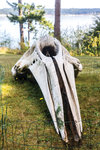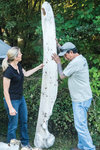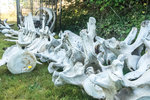Summer is the time for backyard barbecues, not backyard whale decomposition.
But for veterinarian Stefanie Worwag and her husband, retired police officer Mario Rivera, documenting the process as the flesh slowly melted off the corpse of a gray whale over three months was the perfect summer activity.
This item is available in full to subscribers.
We have recently launched a new and improved website. To continue reading, you will need to either log into your subscriber account, or purchase a new subscription.
If you had an active account on our previous website, then you have an account here. Simply reset your password to regain access to your account.
If you did not have an account on our previous website, but are a current print subscriber, click here to set up your website account.
Otherwise, click here to view your options for subscribing.
* Having trouble? Call our circulation department at 360-385-2900, or email our support.
Please log in to continue |
|



Summer is the time for backyard barbecues, not backyard whale decomposition.
But for veterinarian Stefanie Worwag and her husband, retired police officer Mario Rivera, documenting the process as the flesh slowly melted off the corpse of a gray whale over three months was the perfect summer activity.
“I think 95% of the decomposition was all by maggots,” Worwag said, adding that she was surprised how quickly the process went. The maggots, she said, were her favorite part to watch.
The whale arrived at the beach at their property off of Oak Bay Road in Port Hadlock on June 2. At that point, it had been dead for one week. Through their volunteer work at the Marine Science Center, Rivera and Worwag are part of the Marine Mammal Stranding Network, a group of volunteers that spring into action to either rescue the living or evaluate the dead before coming up with a plan for disposal.
When the National Oceanic and Atmospheric Administration was searching for a property to host a dead gray whale, Worwag and Rivera stepped up, not overly worried about the smell.
The whale was towed and left immediately below their bluff home on the beach where NOAA performed a necropsy.
According to NOAA, since January 2019, there has been an increase in gray whale strandings along the west coast of North American from Mexico through Alaska.
“A lot of these whales have been unusually skinny and underweight,” said Michael Milstein, Public Affairs Officer at NOAA. “That was the case with this whale as well.”
Gray whales feed for the summer in the Arctic, Milstein said. This feeding normally lasts them through the rest of the year and their migration, where they don’t do much feeding at all.
“It seems that on the way back to the Arctic they have been running out of their nutritional stores and dying,” he said.
NOAA has declared this an Unusual Mortality Event (UME). As of August, there have been 34 gray whale strandings in Washington.
Full or partial necropsy examinations were conducted on some of the whales, including the one on Worwag and Rivera’s property. According to NOAA, preliminary findings in several of the whales have shown evidence of emaciation.
After the necropsy was complete, the waiting began for Rivera and Worwag while the maggots got to work.
Where there was once the rotting blubber of a dead whale, now lies only flippers, a few bones, and pieces of dried-up leathery whale skin.
To aid in the decomposition, they have been sprinkling lime over the body.
“Lime is supposed to help with the smell and accelerate decomposition,” Worwag said. “This is actually the first time it has been used here on the west coast on a whale, so there’s no comparison.”
The lime may or may not have helped the smell, Worwag added. Altogether, the smell was worth it in the name of scientific study.
“There were days you smelled it more, but overall I’m amazed that it wasn’t that bad,” she said.
Even with her background in veterinary sciences, Worwag was surprised how easy it was to spot key structures of the cetacean’s bony frame.
“It’s so amazing how similar the skeletons are, the anatomy is, to humans and other animals,” she said.
Sure the whale has a six foot mandible, but that’s just a larger version of a jaw bone that you might find in a dog or a cat.
“It’s similar, but at a different scale,” she said.
The last, slowest part of decomposition is the tail end of the whale.
“There are tons of really big muscles and tendons there because they use their tails for movement,” Worwag said. “I think that’s why that part takes so long.”
Now, with little left to decompose, Worwag and Rivera have moved the massive bones of the whale piece by piece up the stairs from the beach into their grassy backyard.
“We got our muscle workout for that,” Worwag said. “Most of the bones we carried up just the two of ourselves. For the bigger ones, we had a couple guys helping Mario carry them up the stairs.”
Moving the skull took a bit more effort, so Worwag and Rivera got help from volunteers at the Community Boat Project. Nahja Chimenti, with a team of students, built a canvas stretcher and wooden float for the skull, which they then towed to the Oak Bay county park, loaded in a car and placed in Worwag and Rivera’s back yard.
Surrounded by a small fence in their backyard, so their three dogs don’t get into it, Worwag and Rivera are storing the bones for future cleaning. But with a pile of rib bones that are six feet tall, Worwag and Rivera aren’t sure how they’re going to get them all cleaned.
In previous Marine Mammal Stranding projects, the Port Townsend Marine Science Center boiled the bones in water to clean them of any leftover debris. But even a fifty-gallon container might not be big enough for some of the bones, let alone the skull.
“We’re planning to start the cleaning process this fall,” Rivera said. “Then we’re hoping to do the assembly of the skeleton next summer.”
Rivera said they are hoping to get some students involved in the process, especially since Chimacum high school teacher Julianne Bonnell found the whale’s baleen washed up on the beach. Rivera and Worwag are hoping to team up with students for the assembly of the whale skeleton.
“It’s an amazing educational opportunity,” he said.